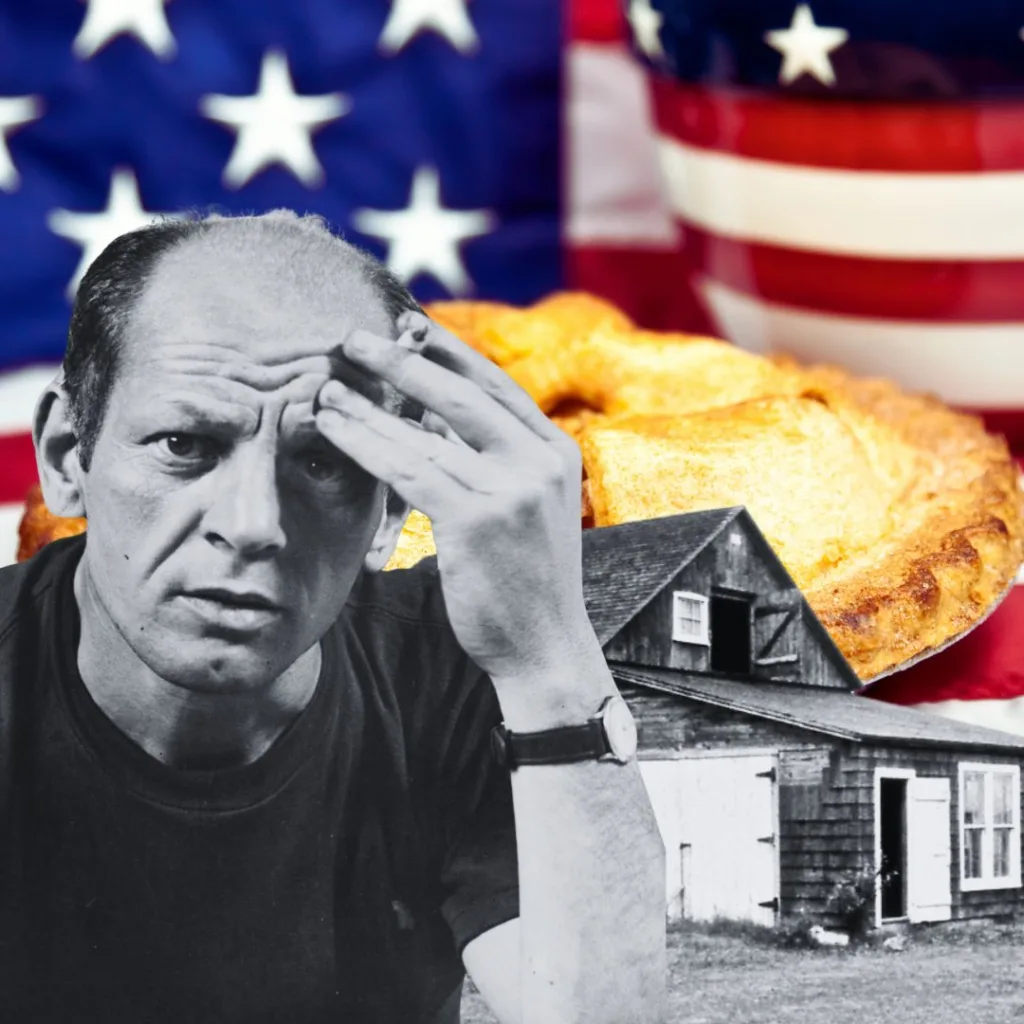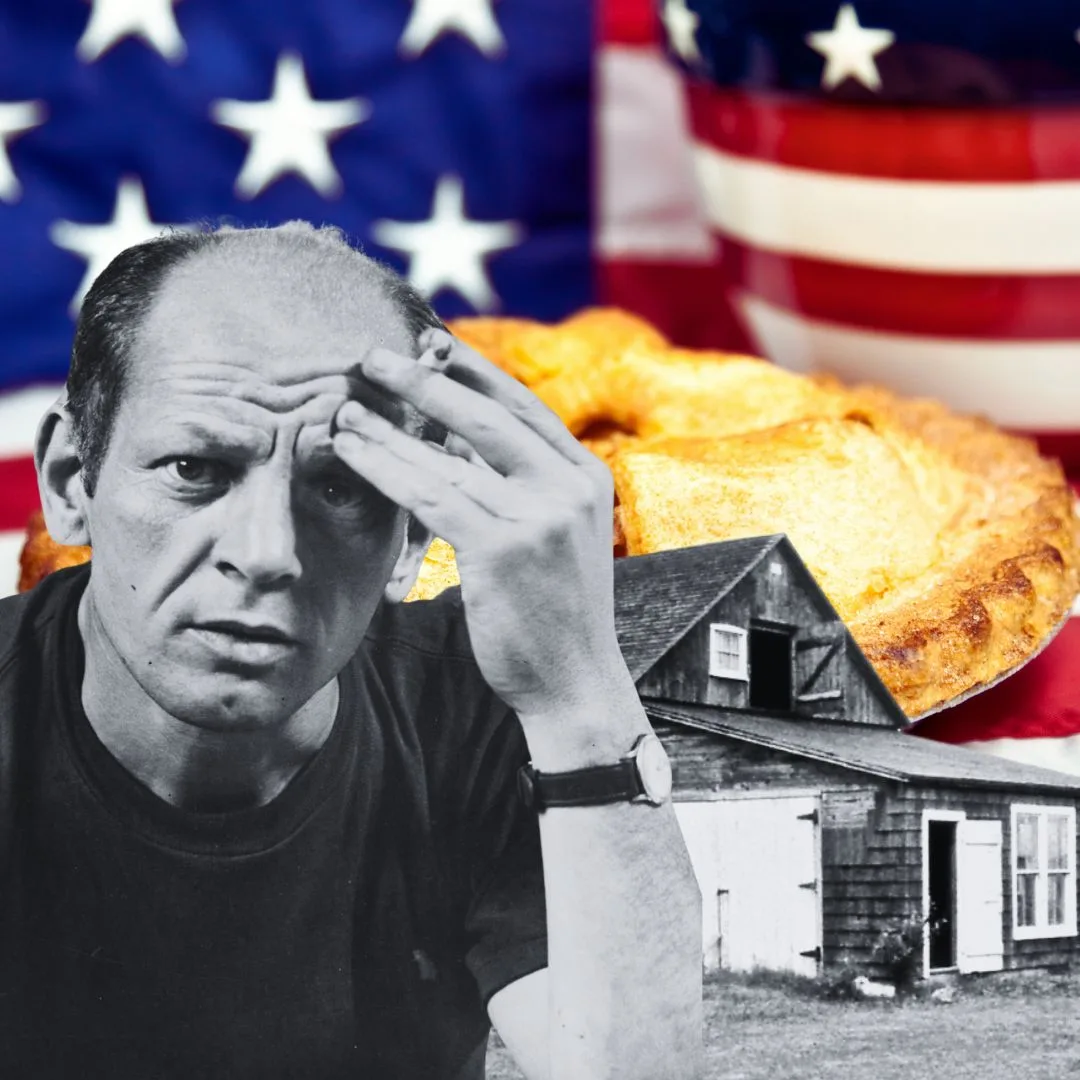Known for his revolutionary drip paintings, Jackson Pollock’s American kitchen was a space of contrast—a retreat from the intensity of his art. Here, he found solace in the simplicity of traditional American food, grounding himself in rituals like pie-baking that reflected a quieter, more rooted side of his identity.
As November settles in and Americans prepare to gather for Thanksgiving—a holiday marked by reflection, tradition, and the comfort of familiar flavors—the image of a pie baking in the oven feels like a gentle invitation to slow down. The warmth, the aroma of cinnamon and apples, and the act of preparing a favorite recipe are rituals many look forward to.
- 21 Best Fall Picture Books for Kids: Must-Have Reads for Autumn
- Pumpkins in Art History: Exploring Famous Pumpkin Paintings for National Pumpkin Day
For Jackson Pollock, the iconic American artist, these quiet comforts held particular significance.
Known for his bold drip paintings that shook the art world, Pollock also found peace in the simple, grounding act of baking.
It’s 1954, and Pollock is in the kitchen of his modest home in Springs, Long Island. His hands, often covered in paint, are now dusted with flour. The smell of apples fills the air, and the deliberate motions of rolling out pie dough provide a sense of calm. This isn’t the frenzy of his studio—there’s no chaotic energy here, no splatters of paint flying in all directions. Instead, Pollock is preparing what would become a prize-winning apple pie at the local Fisherman’s Fair. Baking, for Pollock, wasn’t just a chore; it was a moment of stillness in a life often marked by turbulence.
In this installment of Art Bites, we step away from the chaos of his canvases and into Jackson Pollock’s American kitchen, where his love for apple pie and traditional Thanksgiving foods reveals a softer, quieter side of the artist, as it was through these simple pleasures that Pollock remained connected to his roots and his ongoing search for balance.
An Artist’s Taste for Simplicity
For Pollock, food wasn’t about indulgence or extravagance. Raised in Wyoming and spending his formative years in Arizona and California, he had an appreciation for hearty, comforting dishes that reflected his upbringing in the rugged American West. He loved stews, roasted meats, vegetables from his garden, and, most of all, pies. Even after rising to fame in New York, mingling with the city’s cultural elite, Pollock’s palate remained firmly rooted in the unpretentious, rustic American fare that had shaped him.
His apple pie, which famously won first prize at the Fisherman’s Fair, was a true reflection of this simplicity. In many ways, it stood in contrast to the intensity of his abstract paintings. Where his canvases were bold, chaotic, and full of movement, his pie-making was deliberate, measured, and grounded.
The act of rolling out dough, peeling apples, and watching a pie bake in the oven gave Pollock something that painting often couldn’t—a sense of calm and control. In that kitchen, amidst the quiet ritual of baking, Pollock found a peaceful rhythm that offered a rare moment of escape from the demands of his art and fame.
The Pollock-Krasner Kitchen: A Space of Creation and Calm
Pollock’s home in Springs, Long Island, where he lived with his wife, fellow painter Lee Krasner, was modest, a retreat from the intensity of New York. The kitchen, small but filled with natural light, became a place where both artists could step away from the pressures of the art world.
Krasner often described Pollock as methodical in the kitchen, a cook who brought a quiet focus to baking and meal preparation. It was a stark contrast to the wild energy he poured into his painting.
While his studio was a space of intensity, where creativity surged in unpredictable waves, the kitchen was a space of calm. The simple acts of chopping, mixing, and baking were soothing for Pollock, offering a different kind of creation—one that brought him back to basics, away from the abstract world of his art. Pie-making, for Pollock, became an antidote to the chaos of his professional life, a moment of stillness in a world that often felt anything but still.
The American Pie: Tradition and Identity
As an artist who came to symbolize post-war American art, Pollock’s identity was deeply intertwined with the idea ofwhat it meant to be American. His art captured the spirit of a country in transformation. And yet, in his personal life, Pollock seemed to crave simplicity, something that tethered him to his roots and to a quieter, more grounded existence.
His love for traditional American food, especially his apple pie, reflected this desire for groundedness. The pie wasn’t just a dessert; it was a symbol of home, a connection to place and tradition. It was a reminder of where he came from, a way to return to something solid in a life that often felt adrift. For Pollock, the simple act of baking a pie—rolling out the dough, arranging the apples—was an extension of his need for balance and control, offering him a rare sense of peace amidst the unpredictability of both his career and personal struggles.
As Americans gather this month to celebrate Thanksgiving, reminiscing over shared meals and family traditions, it’s easy to picture Pollock finding a similar kind of solace in his kitchen. The smell of baking apples, the warmth of the oven, the quiet satisfaction of pulling a perfect pie from the rack—these were the moments that allowed Pollock to reconnect with the earthier, more tangible aspects of his life. In a way, his apple pie was as much a part of his American identity as the iconic paintings that would go on to shape modern art.
Jackson Pollock’s Prize-Winning Apple Pie Recipe (via National Gallery of Australia)
Though he’s remembered for his bold, revolutionary paintings, Pollock’s legacy as a pie-maker also holds a special place in his story.
In 1954, his apple pie took first prize at the Fisherman’s Fair in Springs, Long Island—a testament to his surprising skill as a baker.
Below is the recipe, a reflection of his love for simple, traditional American food.
Serves 8
For the filling:
- 4 lb of Granny Smith apples (or a combination of tart apples)
- ¼ cup water
- 1 cup sugar (or less, to taste)
- 1 tsp cinnamon
- ½ tsp nutmeg
- 1 tsp all-purpose flour, sifted
For the crust:
- 2½ cups all-purpose flour
- 1 tsp baking powder
- 1 tsp salt
- 1½ cups cold butter
- 2 egg yolks (plus 1 whole egg for egg wash)
- ½ cup cold milk (or more as needed)
Instructions:
- Prepare the filling: Peel, core, and thinly slice the apples. In a pot, stew the apples with just enough water to cover them, along with the sugar, cinnamon, and nutmeg. Cook until the apples are just tender, then let them cool in some of the juice. Once cooled, sift the flour over the apples and stir gently to combine. Set aside.
- Make the crust: Preheat the oven to 450°F (230°C). In a bowl, mix the flour, baking powder, and salt. Cut in the cold butter until the mixture resembles coarse crumbs. Add the egg yolks and enough milk to form a soft dough. Roll the dough out lightly and line a greased 10-inch pie dish, allowing the pastry to overhang the edge by about an inch.
- Assemble the pie: Pour the apple filling into the pie shell and distribute it evenly. Roll out the remaining dough for the top crust. For a simple finish, lay the dough over the apples and crimp the edges to seal. For a more decorative touch, cut the dough into strips and weave a lattice pattern over the top. Brush the crust with egg wash and sprinkle with a pinch of sugar.
- Bake: Place the pie in the oven and bake at 450°F for 10–15 minutes. Reduce the heat to 325°F (165°C) and bake for an additional 25–30 minutes, or until the crust is golden brown and the filling is bubbling.
Jackson Pollock’s apple pie, much like his art, was a blend of precision and passion. As you savor this recipe, perhaps you’ll find a small connection to the man behind the bold splashes of paint—a man who, in the quiet of his kitchen, found comfort in the simple, grounding act of baking.
Save for Later:
Inside Jackson Pollock’s American Kitchen
Explore Jackson Pollock’s love for simple American food, a quiet tradition that connected him to his…
Introducing Art Bites: A Journey Through Artists and Their Favorite Foods
What did Frida Kahlo cook in her vibrant kitchen? How did Salvador Dalí turn dinner into surrealist …
Into Frida Kahlo’s Kitchen: The Mexican Food that Inspired Her Art and Life
Step into Frida Kahlo’s kitchen at Casa Azul and uncover how her favorite Mexican dishes, like mole …


